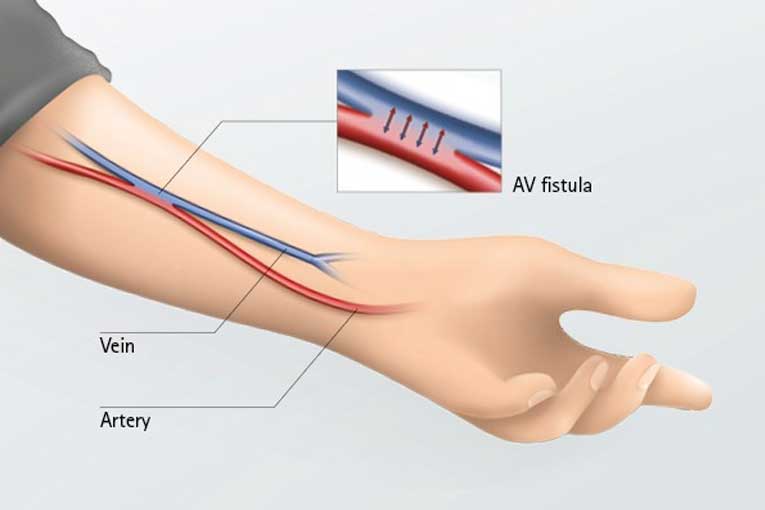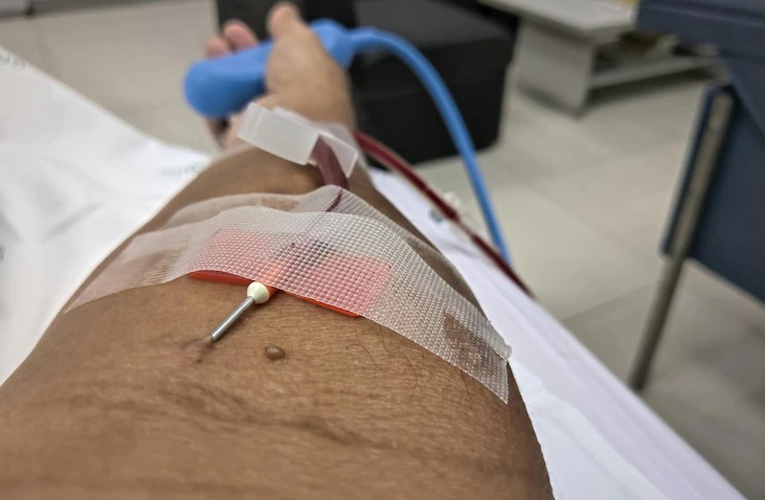- Phone: +91 90020-32757
- info@nefronkidneycare.com
- Mon-Fri (10am - 6pm)


What is AV fistula?
An arteriovenous fistula (AV fistula) is a vascular access used for hemodialysis treatments in people with end stage renal disease (ESRD). It is the preferred vascular access type for hemodialysis because it is associated with fewer complications and better long-term outcomes than other types.
An AV fistula is created by surgically joining a vein and an artery, usually in the arm. This creates a direct connection between the artery and vein, allowing for high flow rates during dialysis treatments. The high flow rate helps to reduce the risk of clotting and infection.
The AV Fistula procedure

The procedure to create an AV fistula is relatively simple and can be done in an outpatient setting. The surgeon will make a small incision in the skin and then use a needle to puncture the artery and vein. The ends of the artery and vein are then sewn together and the incision is closed. The fistula may take several weeks to heal and mature before it can be used for dialysis.
Once the fistula is mature and ready for use, a needle is inserted into the fistula to allow the dialysis machine to access the blood vessels. The needle can be inserted and removed several times over the course of dialysis treatments, so it is important to take care of the fistula to reduce the risk of infection.
AV fistulas are highly beneficial for people with ESRD because they provide a safe and reliable way to access the blood vessels for hemodialysis treatments. They are associated with fewer complications than other types of vascular access and are more durable, meaning they last longer and can be used more often. This can help to reduce the need for additional procedures and improve the quality of life for ESRD patients.
If you have ESRD and are considering an AV fistula, talk to your doctor to learn more about the procedure and to determine if it is right for you.
The Symptoms of AV fistula
The most common symptoms of an Arteriovenous fistula (AV fistula) include:
- 1. A visible bulge or lump at the point of connection between the artery and the vein.
- 2. Aching, throbbing, or burning sensation at the site of the fistula.
- 3. Swelling in the arm or leg associated with the fistula.
- 4. A reddish or purplish discoloration of the skin around the fistula.
- 5. Pain or discomfort with certain arm or leg movements.
- 6. Development of a hematoma (blood clot) near the fistula.
- 7. Infection at the fistula site.
- 8. Numbness or tingling in the arm or leg associated with the fistula.
The benefits of an AV fistula
- 1. It is a reliable and long-term option for Hemodialysis access.
- 2. It provides a direct connection between an artery and vein, which allows for efficient and safe blood flow.
- 3. It often provides a more comfortable and less painful option for the patient when compared to other types of dialysis access.
- 4. It requires fewer catheter changes and offers greater protection against infection.
- 5. It allows for quicker and easier dialysis treatments.
- 6. It is possible to perform certain procedures (such as angiography) through the AV fistula, making it a versatile and beneficial option.
How is AV fistula created?

An AV fistula is a surgically-created connection between an artery and vein in the arm. It is typically created by a vascular surgeon in an outpatient procedure. The surgeon will make an incision in the skin of the arm and dissect down to the artery and vein that will be used for the fistula.
The artery and vein are then connected together, and a cuff is placed around the exterior of the fistula to maintain its integrity. The fistula is typically tested to ensure that it is working properly before the procedure is completed.
What is an AV fistula used for?
An AV fistula is a surgically created connection between an artery and a vein, usually in the arm. It is most commonly used for hemodialysis, a procedure used to cleanse the blood of waste products in people with chronic kidney failure. It can also be used for other medical procedures such as administering intravenous medications and taking blood samples.
Why is AV fistula used for dialysis?
An AV fistula is used for dialysis because it provides a stronger, more reliable and long-term access for dialysis than other types of access. It is surgically created by connecting an artery to a vein in the arm.
This type of access has a lower risk of infection and clotting, and the larger diameter of the fistula allows for higher blood flow during dialysis. It also provides a more comfortable and convenient access for dialysis as it can be used repeatedly, and the fistula can be maintained for many years as long as it is properly cared for.
What type of surgery is AV fistula?
An AV fistula is an artificial connection between an artery and a vein created through surgery. The procedure is used to improve blood flow for hemodialysis for people with kidney failure. The fistula is typically created by a vascular surgeon in an operating room, using local anesthesia. During the procedure, an incision is made in the arm, and the artery and vein are connected together with sutures or stitches. After the procedure, the fistula must have time to heal and mature before it can be used for hemodialysis.
What are the three types of fistula?
1. Arteriovenous Fistulas: This type of fistula is an abnormal connection between an artery and a vein. It can occur naturally or be created surgically to treat certain diseases.
2. Enterocutaneous Fistulas: This type of fistula is an abnormal connection between the intestine and the skin. It is usually caused by surgery or trauma, and can lead to skin infections or dehydration.
3. Traumatic Fistulas: This type of fistula is an abnormal connection between two parts of the body, usually caused by an injury or trauma. It can occur in any part of the body, but is most common in the head, neck, and chest. Traumatic fistulas can cause infection or blockages in the body.
Is AV fistula temporary or permanent?
An AV fistula is a permanent medical procedure that involves surgically creating a connection between an artery and a vein in the arm or leg. The fistula is used to access blood for dialysis treatment.
How long do AV fistulas last?AV fistulas typically last for many years, with a success rate of 80-90%. However, some may last less than one year if the fistula does not mature correctly or becomes blocked or infected. The patient's lifestyle, health, and age can all affect the longevity of the fistula.
Why choose Nefron for fistula treatment?At Nefron we have, specialists who have experience and expertise in treating fistulas, which are abnormal connections between two organs or blood vessels. As a leading fistula care clinic in siliguri, we first identify the cause of the fistula and develop a treatment plan tailored to the individual patient's needs. Depending on the type of fistula, the treatment may involve repairing, closing, or draining the fistula. A fistula surgeon can also recommend lifestyle changes to help prevent future occurrences.


